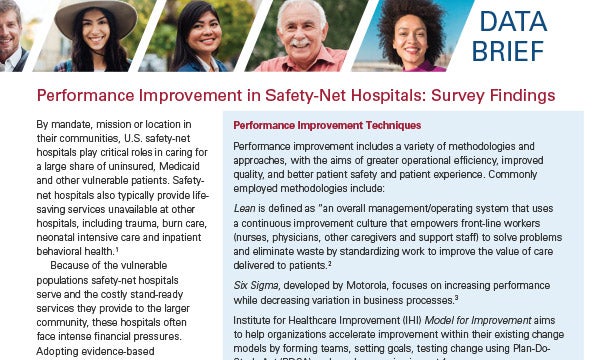
Redesigning Care for Vulnerable Populations
Performance Improvement in Safety-Net Hospitals
Population health management is a suite of tools “to improve health, well-being, and equity for defined or place-based populations.” Among these tools are formal performance improvement (PI) approaches, including Lean, Six Sigma, and Robust Process Improvement, that aim to increase efficiency, promote safety and advance quality for patients, including defined populations.
One setting for using these PI approaches is in hospitals and health systems that serve a safety-net mission. These hospitals provide needed, stand-ready care for patients with complex social needs. Due to narrow operating margins, they may have fewer resources to invest, leading some to ask whether they face unique challenges to adopting formal PI approaches.
With generous support from The Commonwealth Fund, the AHA, in collaboration with NORC at the University of Chicago and with support from the Center for Lean Engagement and Research in Healthcare (CLEAR) at UC-Berkeley, conducted a mixed-methods study to better understand the use and challenges of PI in safety-net hospitals.
What We Learned
Despite ongoing challenges, safety-net hospitals are finding ways to improve efficiency, quality and safety for the patients and communities they serve.
Over the course of the study, we conducted 57 in-depth interviews with senior leaders, front-line clinicians and support staff at 14 diverse safety-net hospitals across the United States. Analysis of these interviews uncovered successful approaches to doing PI and proven approaches to overcoming common barriers to sustaining PI initiatives.
Hospitals across the U.S., including those that serve a safety-net mission, are actively engaged in performance improvement.
We also found that safety-net and non-safety-net hospitals use PI in ways that are not statistically different from one another. In the face of noteworthy challenges, the nation’s safety-net hospitals report being as active in PI as their counterparts.
Common Barriers
- Resistance to change
- Limited access to robust data
- Competing priorities
- Lower margins
- Complex patient populations
- Limited resources
Overcoming Barriers
- Clear communication
- Alignment with strategic plan
- Board and leadership engagement
- Data transparency
- Consistent leadership to drive continuous improvement
- Empowering PI champions
- Investing in a culture of performance improvement
Resources
Videos
Health Care Moments of Truth Talks
These leadership talks highlight key elements for PI work in hospitals and health systems: engaging C-suite leaders and board members, collecting and using actionable data, empowering front-line staff, and ensuring performance improvement work is supported and prioritized.
Issue Brief
Understanding Performance Improvement in Safety-net Hospitals
This issue brief describes best practices and challenges around performance improvement in safety-net hospitals. It also highlights case examples of safety-net hospitals that are transforming the way they deliver high-quality care by integrating PI techniques and methods to improve health outcomes.
Data Brief
Performance Improvement In Safety-net Hospitals
This data brief focuses on the methodology of this study on performance improvement in safety-net hospitals. Findings indicate that safety-net hospitals are embracing performance improvement, despite the challenges.





